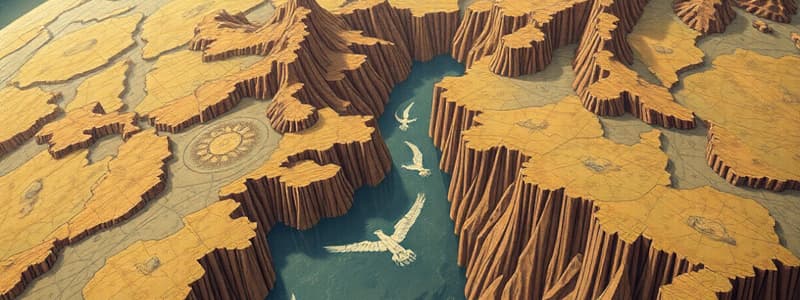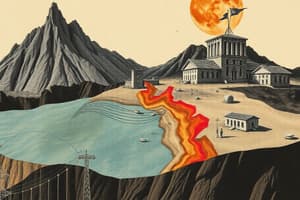Podcast
Questions and Answers
According to the elastic rebound theory, what process directly leads to the shaking of the ground during an earthquake?
According to the elastic rebound theory, what process directly leads to the shaking of the ground during an earthquake?
- The release of accumulated energy when a fault slips. (correct)
- The movement of convection currents deep within the Earth.
- The formation of new fault lines in areas of high tectonic activity.
- The initial collision of tectonic plates initiating the buildup of pressure.
Why do earthquakes primarily occur at the boundaries between tectonic plates?
Why do earthquakes primarily occur at the boundaries between tectonic plates?
- The density of the Earth's crust is lower at these points.
- The convection currents in the mantle are weaker beneath plate boundaries.
- The Earth's magnetic field is weaker at plate boundaries.
- These are zones where plates interact, causing friction and pressure to build up. (correct)
What geological feature is a direct result of the interaction and movement of tectonic plates?
What geological feature is a direct result of the interaction and movement of tectonic plates?
- A mid-ocean ridge
- A mantle plume
- A volcanic hotspot
- A fault line (correct)
How do scientists utilize data from previous earthquakes to forecast future seismic events?
How do scientists utilize data from previous earthquakes to forecast future seismic events?
What is the primary reason for the high frequency of earthquakes in the Ring of Fire?
What is the primary reason for the high frequency of earthquakes in the Ring of Fire?
Flashcards
Lithosphere
Lithosphere
The Earth's outermost layer, made of large rock slabs.
Tectonic Plates
Tectonic Plates
Large sections of the lithosphere that fit together.
Fault
Fault
A place where two tectonic plates meet.
Earthquake cause
Earthquake cause
Signup and view all the flashcards
Ring of Fire
Ring of Fire
Signup and view all the flashcards
Study Notes
- The Earth's lithosphere consists of large rock slabs called tectonic plates.
- Faults are formed where two tectonic plates meet.
- Earthquakes are dangerous events caused by sudden plate movements along faults.
- Earthquakes release energy in the form of waves, causing ground shaking that damages structures.
Main Cause of Earthquakes
- Earthquakes primarily result from the sudden slipping of Earth's tectonic plates.
- Tectonic plates move due to convection currents beneath them.
- Friction occurs when plates meet, but continuous pushing from convection currents builds pressure.
- When pressure overcomes friction, plates slip, releasing energy and causing earthquakes.
Elastic Rebound Theory
- The Elastic Rebound Theory explains earthquakes using the analogy of a stretching rubber band.
- Tension builds as the band stretches, and energy is released when the band snaps.
- A fault slip releases energy, causing ground shaking.
Earthquake Locations
- Earthquakes can occur anywhere, but are more common in specific zones.
- Earthquake zones are areas where tectonic plates frequently meet and move.
- Scientists analyze data from past earthquakes to predict when and where future earthquakes may occur.
Ring of Fire
- The Ring of Fire, or Circum-Pacific Belt, is a U-shaped zone along the Pacific Ocean coast, stretching 24,900 miles.
- It connects numerous tectonic plates like the Pacific, Indian-Australia, Philippine, Eurasian, North American, Cocos, Nazca, Antarctic, Caribbean, and South American plates.
- The Ring of Fire is an earthquake hotspot due to plate movement, accounting for 81% of global earthquakes.
Alpide Belt
- The Alpide Belt runs through southern Eurasia and accounts for over 17% of earthquakes worldwide.
- This zone connects the Eurasian, Arabian, Indian, African, and Australian plates.
- Pressure from these plates has formed the Alps and the Himalayas mountain ranges.
Oceanic Ridge Belt
- The Oceanic Ridge Belt, or Mid-Atlantic Ridge, lies between the North American, Eurasian, African, and South American plates.
- It's a divergent boundary where tectonic plates move away from each other, located deep underwater.
- Despite being underwater, strong earthquakes can affect nearby areas like Iceland.
What Happens During an Earthquake
- Earthquakes start at the focus, the underground point where plates meet, and radiate waves to the surface.
- Predicting earthquakes is challenging due to the underground nature of plate movement.
- The epicenter is the location on Earth's surface directly above the focus.
- Strong earthquake waves can severely damage areas near the epicenter.
- Underwater earthquakes, like those in the Mid-Atlantic Ridge, can cause tsunamis.
- Tsunamis are giant, fast-moving waves capable of causing coastal destruction.
Other Earthquake Causes
- Besides tectonic plate slipping, other events can trigger earthquakes.
- Underground explosions: Nuclear explosions can cause smaller earthquakes.
- Collapses: Large rock collapses can shift the crust, causing minor earthquakes.
- Volcanoes: Lava movement beneath the surface can shift the crust, resulting in mild earthquakes.
Studying That Suits You
Use AI to generate personalized quizzes and flashcards to suit your learning preferences.




